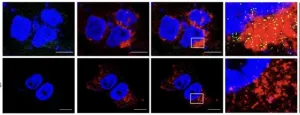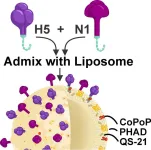(Press-News.org) Shedding light on how the brain fine-tunes its wiring during learning, a new study finds that different dendritic segments of a single neuron follow distinct rules. The findings challenge the idea that neurons follow a single learning strategy and offer a new perspective on how the brain learns and adapts behavior. The brain's remarkable ability to learn and adapt is rooted in its capacity to modify the connections within its neural circuits – a phenomenon known as synaptic plasticity, in which specific synapses are altered to reshape neural activity and support behavioral change. Neurons, unlike most other cell types, are characterized by their intricate, tree-like dendritic arbors, which extend from the cell body and serve as the primary site for receiving signals from other neurons via synaptic inputs. These dendrites are not uniform; instead, they are organized into distinct compartments with specialized anatomical and biophysical properties which likely influence how various patterns of neural activity trigger the biochemical processes that underlie synaptic plasticity. However, how the brain determines which synapses should be modified during learning and whether individual neurons apply the same plasticity rules uniformly across their structurally and functionally distinct dendritic compartments remains unknown.
To explore how synapses function and adapt during learning, William Wright and colleagues used advanced imaging to observe single synapses in the motor cortex of mice as the animals learned new motor skills. Wright et al. trained mice on a motor task known to drive synaptic plasticity in layer 2/3 motor cortex neurons, observing clear behavioral signs of learning over two weeks. Then, to investigate how individual synapses adapt during this process, Wright et al. used in vivo two-photon imaging with molecular sensors that simultaneously tracked synaptic input (via glutamate release) and neuronal output (via calcium activity). The authors discovered that learning-related patterns of neural activity drive synaptic plasticity differently across dendritic compartments. In apical dendrites, synapses were strengthened when they were coactive with nearby neighbors, suggesting that plasticity here is governed by local interactions between adjacent inputs. In contrast, plasticity in basal dendrites was linked to the neuron's overall output—strengthening or weakening depending on how synapse activity aligned with global action potential firing. Suppressing a neuron's activity selectively impaired plasticity in basal, but not apical, dendrites. In a related Perspective, Ayelén Groisman and Johannes Letzkus discuss the study and its findings in greater detail.
END
Surprise: Synapses on single neurons follow distinct rules during learning
Summary author: Walter Beckwith
2025-04-17
ELSE PRESS RELEASES FROM THIS DATE:
Fresh insights into why solid-state batteries fail could inform longer-lasting batteries
2025-04-17
Solid-state lithium batteries fail for the same reason over-bent paperclips snap – metal fatigue in the anode itself, according to a new study. The findings, which show that this fatigue follows well-documented mechanical behavior, provide a quantitative framework for predicting the cycle life of solid-state batteries, enabling new pathways for designing longer-lasting and safer energy storage systems. Solid-state lithium metal batteries (SSBs) promise both high energy and improved safety by combining a lithium ...
Curiosity rover identifies carbonates, providing evidence of a carbon cycle on ancient Mars
2025-04-17
NASA’s Curiosity rover has uncovered a hidden chemical archive of ancient Mars’ atmosphere, which suggests that large amounts of carbon dioxide have been locked into the planet’s crust, according to a new study. The findings provide in situ evidence that a carbon cycle once operated on ancient Mars and offer new insights into the planet’s past climate. The Martian landscape shows clear signs that liquid water once flowed across its surface, which would have required ...
Up to 17% of global cropland contaminated by toxic heavy metal pollution, study estimates
2025-04-17
Based on data from over 1000 regional studies combined with machine learning, researchers estimate that as many as 1.4 billion people live in areas with soil dangerously polluted by heavy metals like arsenic, cadmium, cobalt, chromium, copper, nickel, and lead. The study reveals a global risk, but also a previously unrecognized high-risk, metal-enriched zone in low-latitude Eurasia, in particular. The growth in demand for critical metals means toxic heavy metal pollution in soils is only likely to worsen. “We hope that the global soil pollution data presented in this report will ...
Curiosity rover finds large carbon deposits on Mars
2025-04-17
Research from NASA’s Curiosity rover has found evidence of a carbon cycle on ancient Mars, bringing scientists closer to an answer on whether the Red Planet was ever capable of supporting life.
Lead author Dr. Ben Tutolo, PhD, an associate professor with the Department of Earth, Energy and Environment in the Faculty of Science at the University of Calgary, is a participating scientist on the NASA Mars Science Laboratory Curiosity Rover team.
The team is working to understand climate transitions and habitability on ancient Mars as Curiosity explores Gale Crater.
The paper, published this week in the journal Science, reveals that ...
CHOP, Penn Medicine researchers use deep learning algorithm to pinpoint potential disease-causing variants in non-coding regions of the human genome
2025-04-17
Philadelphia, April 17, 2025 – Researchers from Children’s Hospital of Philadelphia (CHOP) and the Perelman School of Medicine at the University of Pennsylvania (Penn Medicine) have successfully employed an algorithm to identify potential mutations which increase disease risk in the noncoding regions our DNA, which make up the vast majority of the human genome. The findings could serve as the basis for detecting disease-associated variants in a range of common diseases. The findings were published online today by the American Journal of Human Genetics.
While certain sections ...
Prevalence of obesity with and without confirmation of excess adiposity among US adults
2025-04-17
About The Study: Among U.S. adults ages 20 to 59, the prevalence of obesity by body mass index (BMI) only was nearly identical with the obesity prevalence after confirmation of excess adiposity. Approximately 98% of individuals identified as having obesity based on BMI had excess adiposity.
Corresponding Author: To contact the corresponding author, Michael Fang, PhD, MHS, email mfang9@jh.edu.
To access the embargoed study: Visit our For The Media website at this link https://media.jamanetwork.com/
(doi:10.1001/jama.2025.2704)
Editor’s Note: Please ...
Population attributable fraction of incident dementia associated with hearing loss
2025-04-17
About The Study: The results of this cohort study suggest that treating hearing loss might delay dementia for a large number of older adults. Public health interventions targeting clinically significant audiometric hearing loss might have broad benefits for dementia prevention. Future research quantifying population attributable fractions should carefully consider which measures are used to define hearing loss, as self-reporting may underestimate hearing-associated dementia risk.
Corresponding Author: To contact the corresponding ...
New study reveals how cleft lip and cleft palate can arise
2025-04-17
CAMBRIDGE, MA -- Cleft lip and cleft palate are among the most common birth defects, occurring in about one in 1,050 births in the United States. These defects, which appear when the tissues that form the lip or the roof of the mouth do not join completely, are believed to be caused by a mix of genetic and environmental factors.
In a new study, MIT biologists have discovered how a genetic variant often found in people with these facial malformations leads to the development of cleft lip and cleft palate.
Their findings suggest that the variant diminishes cells’ supply of transfer RNA, a molecule ...
Scientists hack cell entry to supercharge cancer drugs
2025-04-17
A new discovery could pave the way for more effective cancer treatment by helping certain drugs work better inside the body.
Scientists at Duke University School of Medicine, University of Texas Health Science Center at San Antonio, and University of Arkansas have found a way to improve the uptake of a promising class of cancer-fighting drugs called PROTACs, which have struggled to enter cells due to their large size.
The new method works by taking advantage of a protein called CD36 that helps pull substances into cells. By designing drugs to use this CD36 pathway, researchers delivered 7.7 to 22.3 times more of the drug inside cancer cells, making ...
Study: Experimental bird flu vaccine excels in animal models
2025-04-17
BUFFALO, N.Y. — A vaccine under development at the University at Buffalo has demonstrated complete protection in mice against a deadly variant of the virus that causes bird flu.
The work, detailed in a study published today (April 17) in the journal Cell Biomaterials, focuses on the H5N1 variant known as 2.3.4.4b, which has caused widespread outbreaks in wild birds and poultry, in addition to infecting dairy cattle, domesticated cats, sea lions and other mammals.
In the study, scientists describe a process they’ve developed for creating doses with precise ...
LAST 30 PRESS RELEASES:
Press registration is now open for the 2026 ACMG Annual Clinical Genetics Meeting
Understanding sex-based differences and the role of bone morphogenetic protein signaling in Alzheimer’s disease
Breakthrough in thin-film electrolytes pushes solid oxide fuel cells forward
Clues from the past reveal the West Antarctic Ice Sheet’s vulnerability to warming
Collaborative study uncovers unknown causes of blindness
Inflammatory immune cells predict survival, relapse in multiple myeloma
New test shows which antibiotics actually work
Most Alzheimer’s cases linked to variants in a single gene
Finding the genome's blind spot
The secret room a giant virus creates inside its host amoeba
World’s vast plant knowledge not being fully exploited to tackle biodiversity and climate challenges, warn researchers
New study explains the link between long-term diabetes and vascular damage
Ocean temperatures reached another record high in 2025
Dynamically reconfigurable topological routing in nonlinear photonic systems
Crystallographic engineering enables fast low‑temperature ion transport of TiNb2O7 for cold‑region lithium‑ion batteries
Ultrafast sulfur redox dynamics enabled by a PPy@N‑TiO2 Z‑scheme heterojunction photoelectrode for photo‑assisted lithium–sulfur batteries
Optimized biochar use could cut China’s cropland nitrous oxide emissions by up to half
Neural progesterone receptors link ovulation and sexual receptivity in medaka
A new Japanese study investigates how tariff policies influence long-run economic growth
Mental trauma succeeds 1 in 7 dog related injuries, claims data suggest
Breastfeeding may lower mums’ later life depression/anxiety risks for up to 10 years after pregnancy
Study finds more than a quarter of adults worldwide could benefit from GLP-1 medications for weight loss
Hobbies don’t just improve personal lives, they can boost workplace creativity too
Study shows federal safety metric inappropriately penalizes hospitals for lifesaving stroke procedures
Improving sleep isn’t enough: researchers highlight daytime function as key to assessing insomnia treatments
Rice Brain Institute awards first seed grants to jump-start collaborative brain health research
Personalizing cancer treatments significantly improve outcome success
UW researchers analyzed which anthologized writers and books get checked out the most from Seattle Public Library
Study finds food waste compost less effective than potting mix alone
UCLA receives $7.3 million for wide-ranging cannabis research
[Press-News.org] Surprise: Synapses on single neurons follow distinct rules during learningSummary author: Walter Beckwith

